Influence of Different Warm Mix Additives on Characteristics of Warm Mix Asphalt
Abstract
:1. Introduction
- improvement in working conditions for workers owing to minimised emissions and exposure to less heated work environments;
- reduction in the emission of greenhouse gases, which are harmful to the environment;
- ability to lay bituminous layers at lower temperatures, which results in an increased construction period;
- longer haulage distances;
- easier compaction owing to improved workability;
- quicker commissioning of the bituminous layer for traffic use;
- possibility of adding large quantities of reclaimed asphalt pavement without compromising performance;
- to quantify the effect of additives on the performance of WMA mixtures;
- to evaluate the physical–mechanical characteristics of the different types of WMA;
- to determine the optimum mixing and compaction temperatures suitable for WMA;
- to select the optimum WMA suitable for the climatic and traffic conditions peculiar to Romania.
2. Materials and Methods
2.1. Materials
2.2. Experimental Plan
2.2.1. Bitumen Tests
2.2.2. Asphalt Mixture Tests
- Marshall specimens, which were compacted to 50 blows on each side (fixed compactive effort) using a Marshall hammer;
- specimens compacted using a gyratory compactor at 80 gyrations (to determine the stiffness modulus and resistance to permanent deformation) and 50 gyrations (to determine the water sensitivity).
2.3. Test Methods
2.3.1. Marshall Test
2.3.2. Stiffness—Test Applying Indirect Tension to Cylindrical Specimens (IT-CY)
2.3.3. Resistance to Permanent Deformation—Triaxial Cyclic Compression Test
2.3.4. Water Sensitivity—Indirect Tensile Test
3. Results and Discussion
3.1. Bitumen Test Results
3.1.1. Penetration Index
3.1.2. Dynamic Shear Rheometer Test
3.2. Asphalt Mixture Test Results
3.2.1. Marshall Test
3.2.2. Stiffness—Test Applying Indirect Tension to Cylindrical Specimens (IT-CY)
3.2.3. Resistance to Permanent Deformation—Triaxial Cyclic Compression Test
3.2.4. Water Sensitivity—Indirect Tensile Test
4. Conclusions
Author Contributions
Funding
Institutional Review Board Statement
Informed Consent Statement
Data Availability Statement
Conflicts of Interest
References
- World Commission on Environment and Development. Our Common Future; Oxford Paperbacks; Oxford University Press: New York, NY, USA, 1987; ISBN 978-0-19-282080-8. [Google Scholar]
- Corté, J.-F.; Benedetto, H.D. Matériaux Routiers Bitumineux: Tome 1, Description et Propriétés des Constituants; Hermes Science Publications: Paris, France, 2004; ISBN 978-2-7462-0959-6. [Google Scholar]
- Lucaci, G.; Costescu, I.; Belc, F. Construcţia Drumurilor; Editura Tehnică: București, Romania, 2000. [Google Scholar]
- D’Angelo, J.; Cowsert, J.; Newcomb, D.D. Warm-Mix Asphalt: European Practice; U.S. Department of Transportation: Washington, DC, USA, 2008.
- Nikolaides, A. Highway Engineering: Pavements, Materials and Control of Quality; CRC Press: Boca Raton, FL, USA, 2014; ISBN 978-1-4665-7997-2. [Google Scholar]
- Kristjansdottir, O. Warm Mix Asphalt for Cold Weather Paving; University of Washington: Seattle, WA, USA, 2006. [Google Scholar]
- Nowoświat, A.; Sorociak, W.; Żuchowski, R. The Impact of the Application of Thin Emulsion Mat Microsurfacing on the Level of Noise in the Environment. Constr. Build. Mater. 2020, 263, 120626. [Google Scholar] [CrossRef]
- European Asphalt Pavement Association (EAPA). The Use of Warm Mix Asphalt; EAPA: Helsinki, Finland, 2014. [Google Scholar]
- Woszuk, A. Application of Fly Ash Derived Zeolites in Warm-Mix Asphalt Technology. Materials 2018, 11, 1542. [Google Scholar] [CrossRef] [Green Version]
- Hurley, G.C.; Prowell, B.D. Evaluation of Aspha-Min® Zeolite for Use in Warm Mix Asphalt. In NCAT Report 05-04; Auburn University: Auburn, AL, USA, 2005. [Google Scholar]
- Woszuk, A.; Franus, W. Properties of the Warm Mix Asphalt Involving Clinoptilolite and Na-P1 Zeolite Additives. Constr. Build. Mater. 2016, 114, 556–563. [Google Scholar] [CrossRef]
- Button, J.; Estakhri, C.; Wimsatt, A. A Synthesis of Warm-Mix Asphalt; Texas Transportation Institute: College Station, TX, USA, 2007. [Google Scholar]
- Capitão, S.D.; Picado-Santos, L.G.; Martinho, F. Pavement Engineering Materials: Review on the Use of Warm-Mix Asphalt. Constr. Build. Mater. 2012, 36, 1016–1024. [Google Scholar] [CrossRef]
- Lesueur, D.; González, J.L.; Rubio, A. Use of Hydrated Lime in Warm-Mix Asphalt. In Proceedings of the 5th Eurasphalt & Eurobitume Congress, Istanbul, Turkey, 13–15 June 2012. [Google Scholar]
- Kheradmand, B.; Muniandy, R.; Hua, L.T.; Yunus, R.B.; Solouki, A. An Overview of the Emerging Warm Mix Asphalt Technology. Int. J. Pavement Eng. 2014, 15, 79–94. [Google Scholar] [CrossRef]
- Mohd Hasan, M.R.; You, Z.; Yang, X. A Comprehensive Review of Theory, Development, and Implementation of Warm Mix Asphalt Using Foaming Techniques. Constr. Build. Mater. 2017, 152, 115–133. [Google Scholar] [CrossRef]
- Dong, F.; Yu, X.; Liang, X.; Ding, G.; Wei, J. Influence of Foaming Water and Aging Process on the Properties of Foamed Asphalt. Constr. Build. Mater. 2017, 153, 866–874. [Google Scholar] [CrossRef]
- Woszuk, A.; Zofka, A.; Bandura, L.; Franus, W. Effect of Zeolite Properties on Asphalt Foaming. Constr. Build. Mater. 2017, 139, 247–255. [Google Scholar] [CrossRef]
- Sukhija, M.; Saboo, N. A Comprehensive Review of Warm Mix Asphalt Mixtures-Laboratory to Field. Constr. Build. Mater. 2021, 274, 121781. [Google Scholar] [CrossRef]
- Sengoz, B.; Topal, A.; Gorkem, C. Evaluation of Natural Zeolite as Warm Mix Asphalt Additive and Its Comparison with Other Warm Mix Additives. Constr. Build. Mater. 2013, 43, 242–252. [Google Scholar] [CrossRef]
- Bonaquist, R. Mix Design Practices for Warm-Mix Asphalt; National Academies of Sciences, Engineering, and Medicine: Washington, DC, USA, 2011. [Google Scholar]
- Jamshidi, A.; Hamzah, M.O.; You, Z. Performance of Warm Mix Asphalt Containing Sasobit®: State-of-the-Art. Constr. Build. Mater. 2013, 38, 530–553. [Google Scholar] [CrossRef]
- Hurley, G.; Prowell, B. Evaluation of Sasobit® for Use in Warm-Mix Asphalt. In NCAT Report 05-06; Auburn University: Auburn, AL, USA, 2005. [Google Scholar]
- Ghuzlan Khalid, A.; Al Assi Mohammad, O. Sasobit-Modified Asphalt Binder Rheology. J. Mater. Civ. Eng. 2017, 29, 04017142. [Google Scholar] [CrossRef]
- Petit, C.; Millien, A.; Canestrari, F.; Pannunzio, V.; Virgili, A. Experimental Study on Shear Fatigue Behavior and Stiffness Performance of Warm Mix Asphalt by Adding Synthetic Wax. Constr. Build. Mater. 2012, 34, 537–544. [Google Scholar] [CrossRef] [Green Version]
- Kim, H.; Lee, S.-J.; Amirkhanian, S. Effects of Warm Mix Asphalt Additives on Performance Properties of Polymer Modified Asphalt Binders. Can. J. Civ. Eng. 2010, 37, 17–24. [Google Scholar] [CrossRef]
- Liu, J.; Li, P. Low Temperature Performance of Sasobit-Modified Warm-Mix Asphalt. J. Mater. Civ. Eng. 2012, 24, 57–63. [Google Scholar] [CrossRef]
- Silva, H.; Oliveira, J.; Ferreira, C.; Pereira, P. Assessment of the Performance of Warm Mix Asphalts in Road Pavements. Int. J. Pavement Res. Technol. 2010, 3, 119–127. [Google Scholar]
- National Center for Asphalt Technology. NCAT Evaluates Warm Mix Asphalt; National Center for Asphalt Technology, Auburn University: Auburn, AL, USA, 2005. [Google Scholar]
- Vaitkus, A.; Čygas, D.; Laurinavičius, A.; Perveneckas, Z. Analysis and Evaluation of Possibilities for the Use of Warm Mix Asphalt in Lithuania. Balt. J. Road Bridge Eng. 2009, 4, 80–86. [Google Scholar] [CrossRef]
- Hurley, G.C.; Prowell, B.D. Evaluation of Evotherm® for Use in Warm Mix Asphalt. In NCAT Report 06-02; Auburn University: Auburn, AL, USA, 2006. [Google Scholar]
- Mallick, R.; Bergendahl, J. A Laboratory Study on CO2 Emission from Asphalt Binder and Its Reduction with the Use of Warm Mix Asphalt. Int. J. Sustain. Eng. 2009, 2, 275–283. [Google Scholar] [CrossRef]
- Bower, N.; Wen, H.; Wu, S.; Willoughby, K.; Weston, J.; DeVol, J. Evaluation of the Performance of Warm Mix Asphalt in Washington State. Int. J. Pavement Eng. 2016, 17, 423–434. [Google Scholar] [CrossRef]
- Xiao, F.; Hou, X.; Amirkhanian, S.; Kim, K.W. Superpave Evaluation of Higher RAP Contents Using WMA Technologies. Constr. Build. Mater. 2016, 112, 1080–1087. [Google Scholar] [CrossRef]
- Kumar, G.S.; Suresha, S.N. State of the Art Review on Mix Design and Mechanical Properties of Warm Mix Asphalt. Road Mater. Pavement Des. 2019, 20, 1501–1524. [Google Scholar] [CrossRef]
- Rubio, M.C.; Martínez, G.; Baena, L.; Moreno, F. Warm Mix Asphalt: An Overview. J. Clean. Prod. 2012, 24, 76–84. [Google Scholar] [CrossRef]
- Vaitkus, A.; Čygas, D.; Laurinavičius, A.; Vorobjovas, V.; Perveneckas, Z. Influence of Warm Mix Asphalt Technology on Asphalt Physical and Mechanical Properties. Constr. Build. Mater. 2016, 112, 800–806. [Google Scholar] [CrossRef]
- Topal, A.; Sengoz, B.; Kok, B.V.; Yilmaz, M.; Aghazadeh Dokandari, P.; Oner, J.; Kaya, D. Evaluation of Mixture Characteristics of Warm Mix Asphalt Involving Natural and Synthetic Zeolite Additives. Constr. Build. Mater. 2014, 57, 38–44. [Google Scholar] [CrossRef]
- Raab, C.; Camargo, I.; Partl, M.N. Ageing and Performance of Warm Mix Asphalt Pavements. J. Traffic Transp. Eng. 2017, 4, 388–394. [Google Scholar] [CrossRef]
- Ali, A.; Abbas, A.; Nazzal, M.; Alhasan, A.; Roy, A.; Powers, D. Effect of Temperature Reduction, Foaming Water Content, and Aggregate Moisture Content on Performance of Foamed Warm Mix Asphalt. Constr. Build. Mater. 2013, 48, 1058–1066. [Google Scholar] [CrossRef]
- SR EN 1426 Standard. Bitumen and Bituminous Binders. Determination of Needle Penetration. 2015. Available online: https://shop.bsigroup.com/ProductDetail/?pid=000000000030255311 (accessed on 24 June 2021).
- SR EN 1427 Standard. Bitumen and Bituminous Binders. Determination of the Softening Point. Ring and Ball Method. 2015. Available online: https://shop.bsigroup.com/ProductDetail?pid=000000000030255301 (accessed on 24 June 2021).
- SR 61:1997 Romanian Standard. Bitumen. Test of Ductility. 1997. Available online: https://www.controls-group.com/usa/ductility/research-ductilometer-for-force-ductility-test-on-standard-and-modified-bitumen-ductimeter.php (accessed on 24 June 2021).
- SR EN 12591 Standard. Bitumen and Bituminous Binders. Specifications for Paving Grade Bitumens. 2009. Available online: https://shop.bsigroup.com/ProductDetail?pid=000000000030246429 (accessed on 24 June 2021).
- Romanescu, C.; Răcănel, C. Reologia Lianților Bituminoși Și a Mixturilor Asfaltice; Publisher: Editura Matrix Rom, București, Romania, 2003. [Google Scholar]
- Marasteanu, M.; Clyne, T.; McGraw, J.; Li, X.; Velasquez, R. High-Temperature Rheological Properties of Asphalt Binders. Transp. Res. Rec. 2005, 1901, 52–59. [Google Scholar] [CrossRef]
- Hajikarimi, P.; Fakhari Tehrani, F.; Moghadas Nejad, F.; Absi, J.; Rahi, M.; Khodaii, A.; Petit, C. Mechanical Behavior of Polymer-Modified Bituminous Mastics. I: Experimental Approach. J. Mater. Civ. Eng. 2019, 31, 04018337. [Google Scholar] [CrossRef]
- Zhang, X.; Hoff, I. Comparative Study of Thermal-Oxidative Aging and Salt Solution Aging on Bitumen Performance. Materials 2021, 14, 1174. [Google Scholar] [CrossRef] [PubMed]
- Pavement Interactive. Dynamic Shear Rheometer. Available online: http://www.pavementinteractive.org/dynamic-shear-rheometer (accessed on 20 April 2020).
- SR EN 14770 Standard. Bitumen and Bituminous Binders. Determination of Complex Shear Modulus and Phase Angle. Dynamic Shear Rheometer (DSR). 2012. Available online: https://shop.bsigroup.com/ProductDetail/?pid=000000000030247874 (accessed on 24 June 2021).
- SR EN 12697-34 Standard. Bituminous Mixtures. Test Methods for Hot Mix Asphalt. Marshall Test. 2012. Available online: https://shop.bsigroup.com/ProductDetail/?pid=000000000030251473 (accessed on 24 June 2021).
- SR EN 12697-26 Standard. Bituminous Mixtures. Test Methods. Stiffness. 2018. Available online: https://shop.bsigroup.com/ProductDetail?pid=000000000030330765 (accessed on 24 June 2021).
- SR EN 12697-25 Standard. Bituminous Mixtures. Test Methods. Cyclic Compression Test. 2016. Available online: https://shop.bsigroup.com/ProductDetail?pid=000000000030288544 (accessed on 24 June 2021).
- SR EN 12697-12 Standard. Bituminous Mixtures. Test Methods. Determination of the Water Sensitivity of Bituminous Specimens. 2018. Available online: https://shop.bsigroup.com/ProductDetail/?pid=000000000030330759 (accessed on 24 June 2021).
- SR EN 12697-23 Standard. Bituminous Mixtures. Test Methods. Determination of the Indirect Tensile Strength of Bituminous Specimens. 2017. Available online: https://shop.bsigroup.com/ProductDetail?pid=000000000030326844 (accessed on 24 June 2021).
- SR EN 12697-30 Standard. Bituminous Mixtures. Test Methods. Specimen Preparation by Impact Compactor. 2018. Available online: https://shop.bsigroup.com/ProductDetail?pid=000000000030360936 (accessed on 24 June 2021).
- SR EN 12697-31 Standard. Bituminous Mixtures. Test Methods. Specimen Preparation by Gyratory Compactor. 2019. Available online: https://shop.bsigroup.com/ProductDetail?pid=000000000030366937 (accessed on 24 June 2021).
- AND 605-2016 Romanian Standard. Normativ Privind Mixturile Asfaltice Executate la Cald. Conditii Tehnice de Proiectare, Preparare si Punere in Opera a Mixturilor Asfaltice (Standard Concerning Hot Mix Asphalts. Technical Conditions for Designing, Preparing and Laying Asphalt Mixtures). 2016. Available online: http://cnadnr.ro/sites/default/files/Reglementari-tehnice/AND%20605.pdf (accessed on 24 June 2021).
- Solaimanian, M.; Harvey, J.; Tahmoressi, M.; Tandon, V. Test Methods to Predict Moisture Sensitivity of Hot-Mix Asphalt Pavements. Moisture Sensit. Asph. Pavements Natl. Semin. 2003, 77–110. [Google Scholar]
- Kavussi, A.; Qorbani, M.; Khodaii, A.; Haghshenas, H.F. Moisture Susceptibility of Warm Mix Asphalt: A Statistical Analysis of the Laboratory Testing Results. Constr. Build. Mater. 2014, 52, 511–517. [Google Scholar] [CrossRef]
- Martin, A.E.; Arambula, E.; Yin, F.; Cucalon, L.G.; Chowdhury, A.; Lytton, R.; Epps, J.; Estakhri, C.; Park, E.S. Evaluation of the Moisture Susceptibility of WMA Technologies; The National Academies Press: Washington, DC, USA, 2014. [Google Scholar]
- Xu, S.; Xiao, F.; Amirkhanian, S.; Singh, D. Moisture Characteristics of Mixtures with Warm Mix Asphalt Technologies—A Review. Constr. Build. Mater. 2017, 142, 148–161. [Google Scholar] [CrossRef]
- Belc, A.L.; Pop, I.O.; Belc, F.; Costescu, C.; Fakhari Tehrani, F. Influence of Warm Mix Additives on the Low-Temperature Behavior of Bitumen Using the Bending Beam Rheometer (BBR). Constr. Build. Mater. 2021, 273, 121682. [Google Scholar] [CrossRef]
- Sreedhar, S.; Coleri, E.; Haddadi, S.S. Selection of a Performance Test to Assess the Cracking Resistance of Asphalt Concrete Materials. Constr. Build. Mater. 2018, 179, 285–293. [Google Scholar] [CrossRef]
- Insightful Corporation. S-Plus 6 for Windows, Guide to Statistics; Insightful Corporation: Seattle, WA, USA, 2001; Volume 1. [Google Scholar]
- Sanchez-Alonso, E.; Vega-Zamanillo, A.; Castro-Fresno, D.; DelRio-Prat, M. Evaluation of Compactability and Mechanical Properties of Bituminous Mixes with Warm Additives. Constr. Build. Mater. 2011, 25, 2304–2311. [Google Scholar] [CrossRef]
- Bennert, T.; Maher, A.; Sauber, R. Influence of Production Temperature and Aggregate Moisture Content on the Initial Performance of Warm-Mix Asphalt. Transp. Res. Rec. 2011, 2208, 97–107. [Google Scholar] [CrossRef]
- Cardone, F.; Pannunzio, V.; Virgili, A.; Barbati, S. An evaluation of use of synthetic waxes in warm mix asphalt. In Advanced Testing and Characterization of Bituminous Materials, Two Volume Set; CRC Press: Boca Raton, FL, USA, 2009; ISBN 978-0-429-15171-2. [Google Scholar]
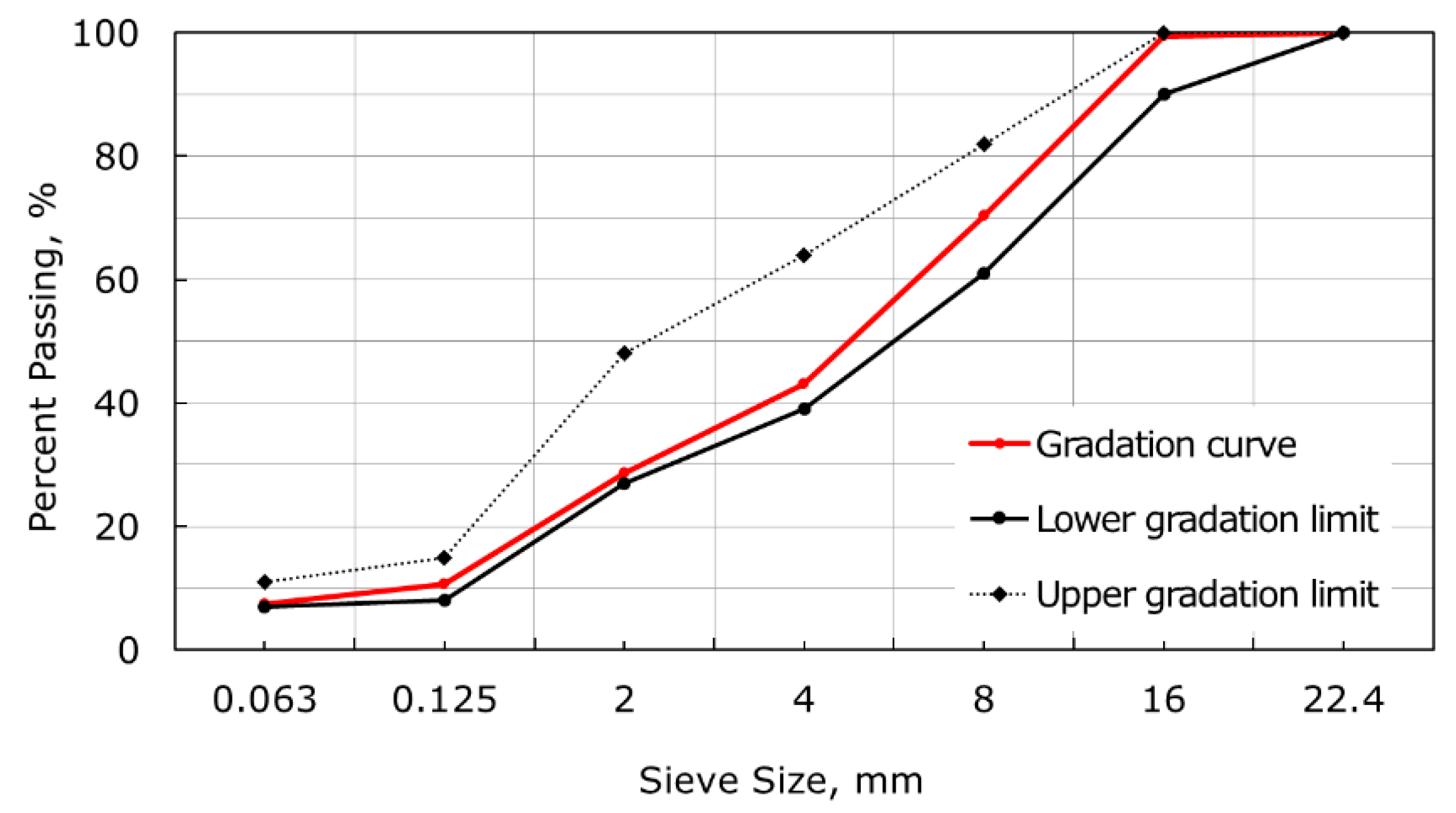
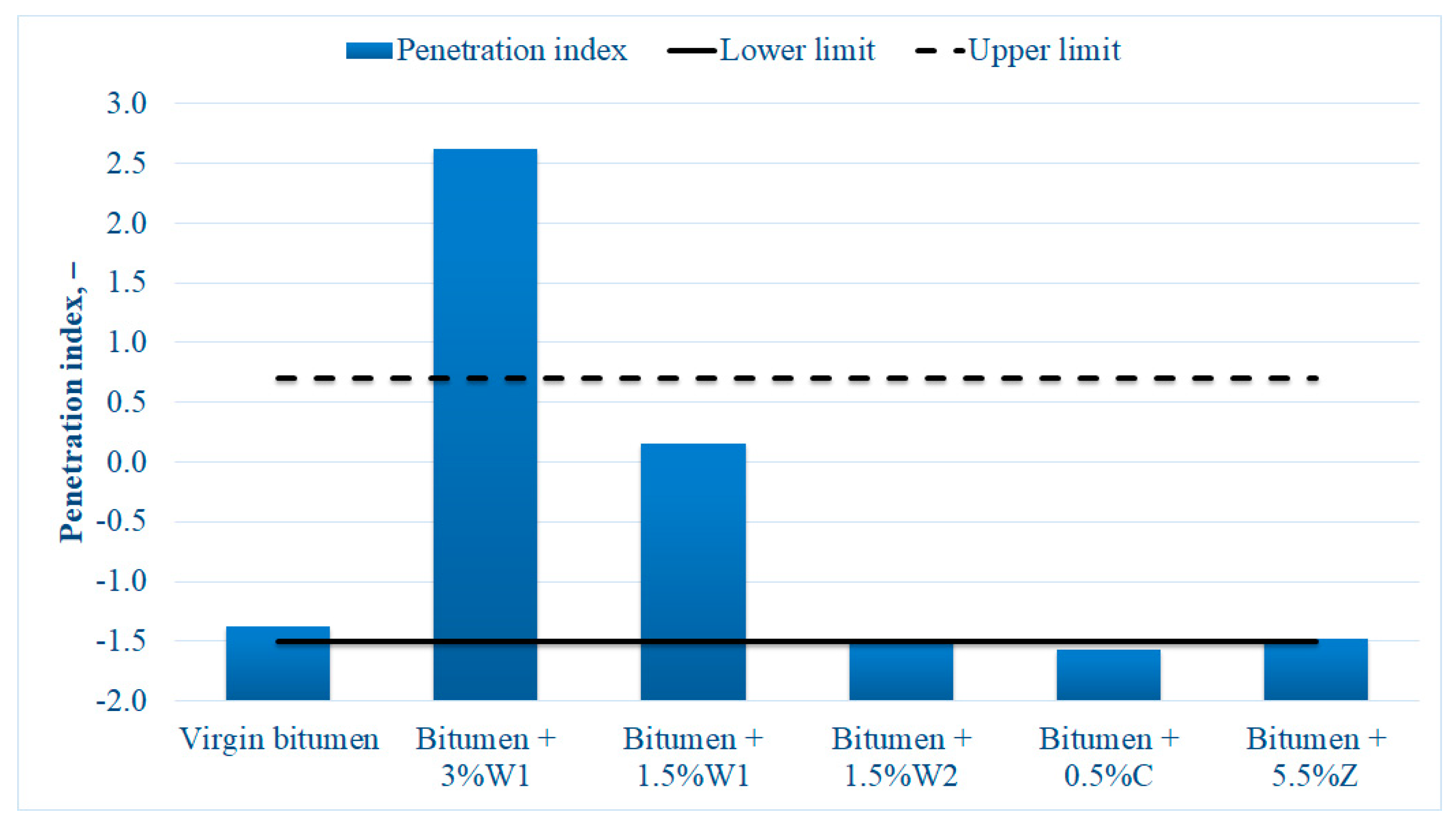

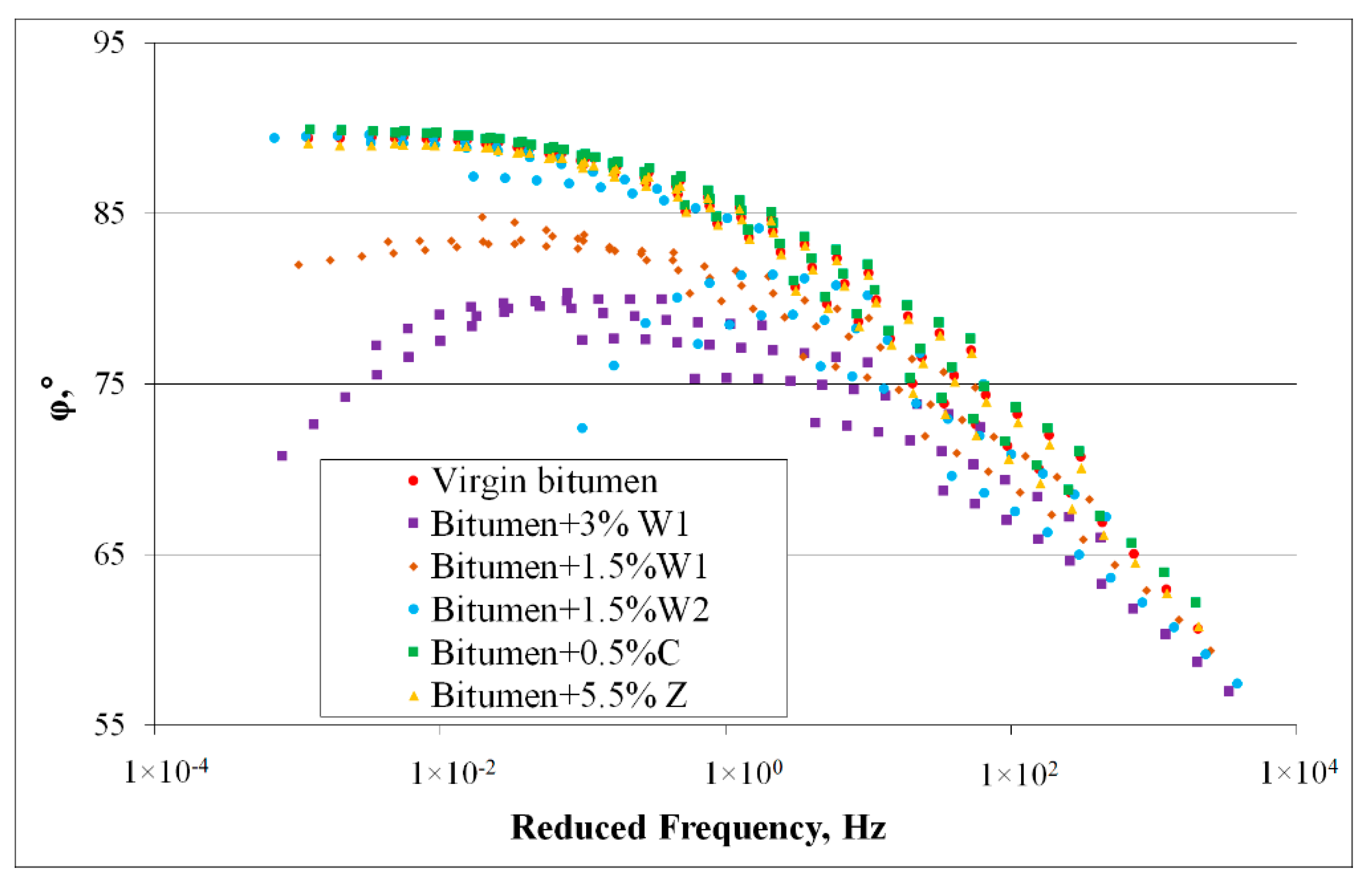

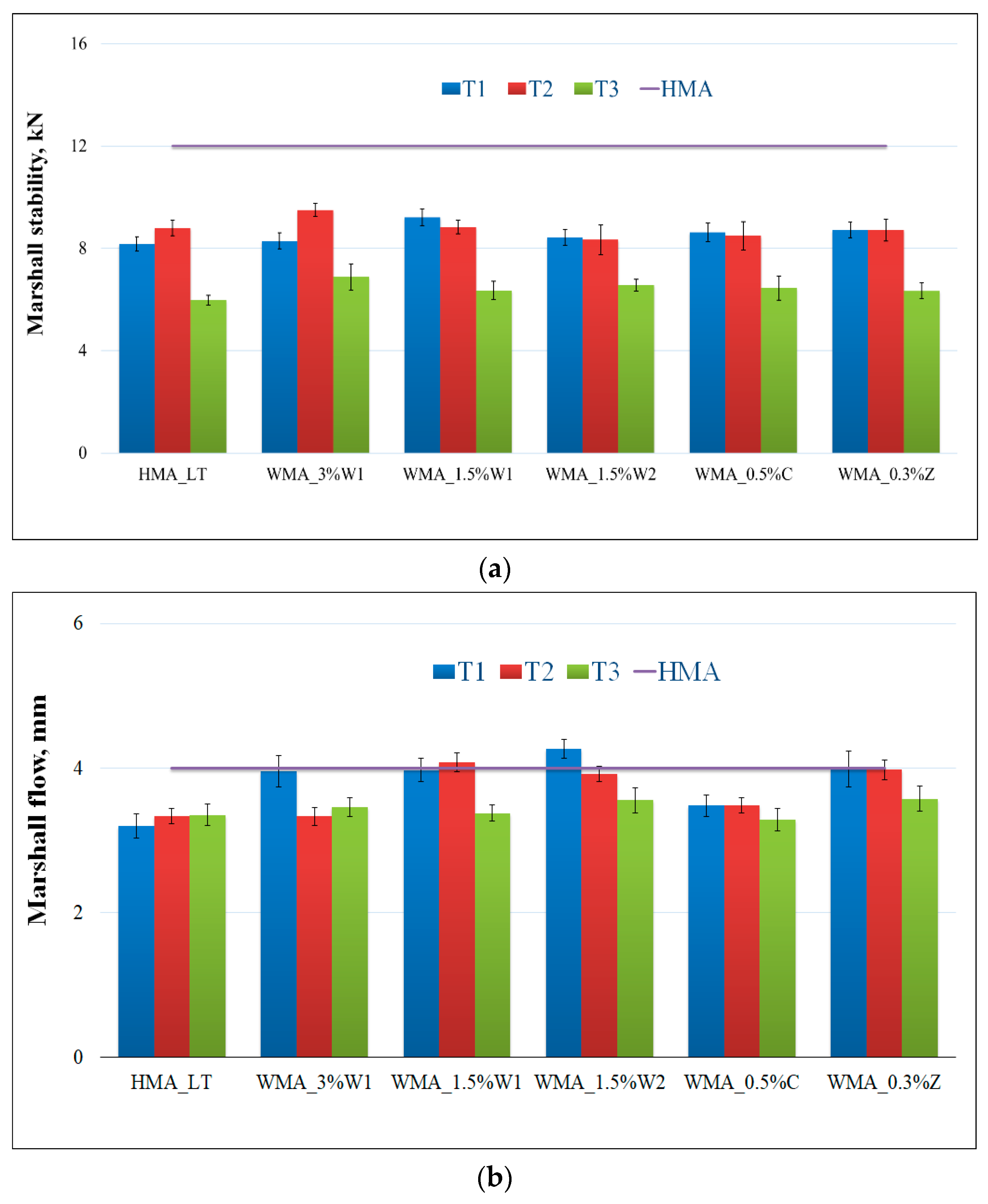
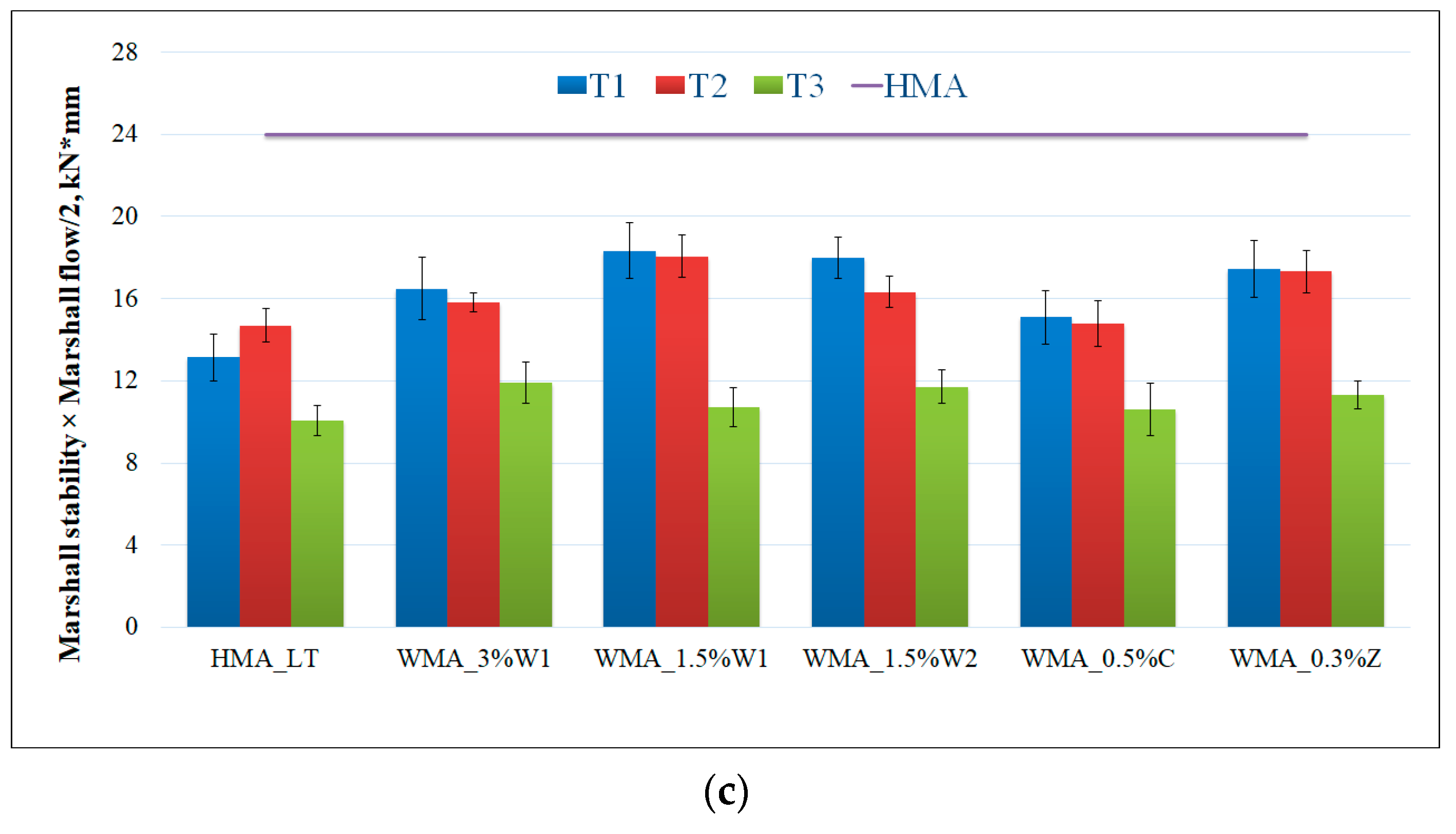
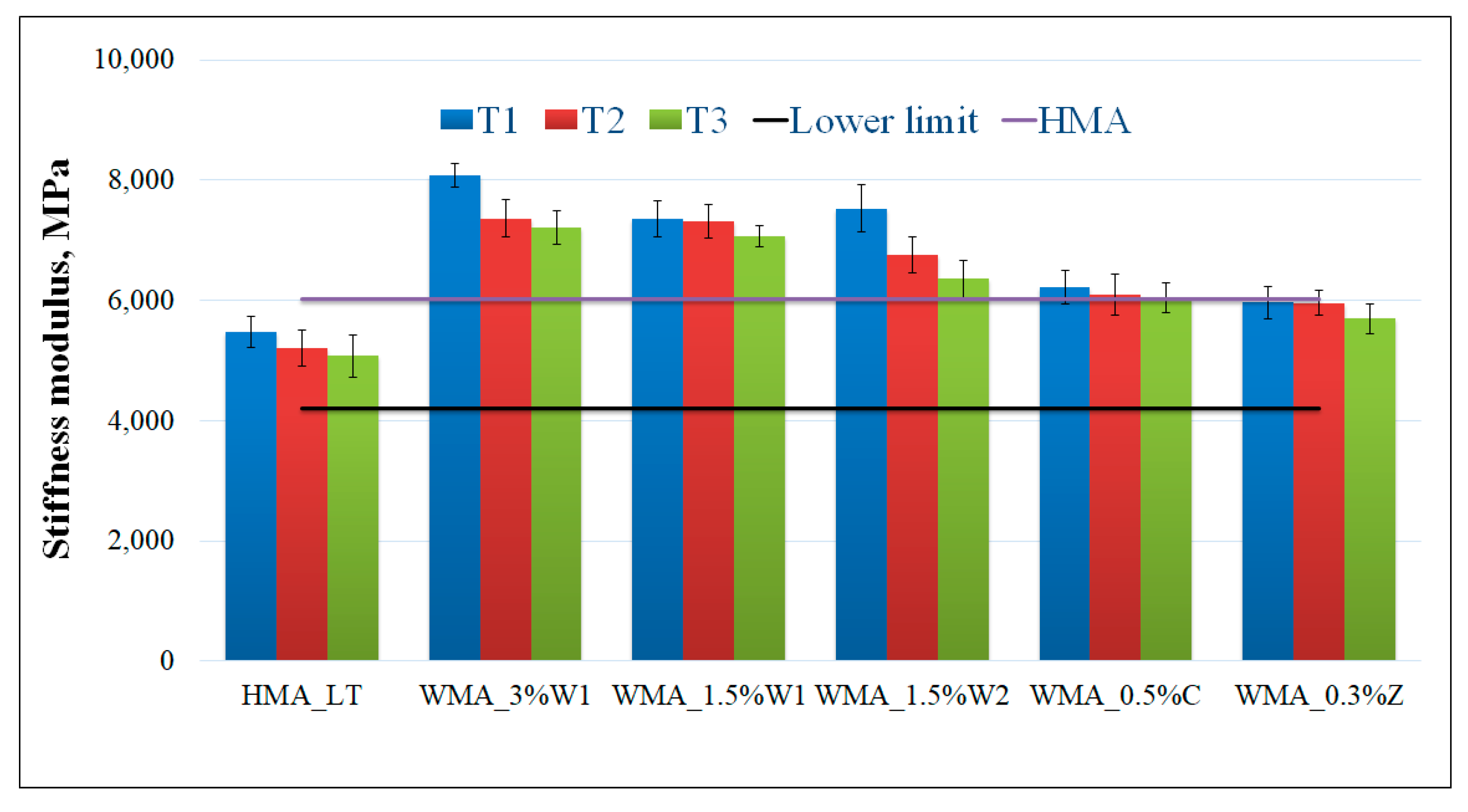
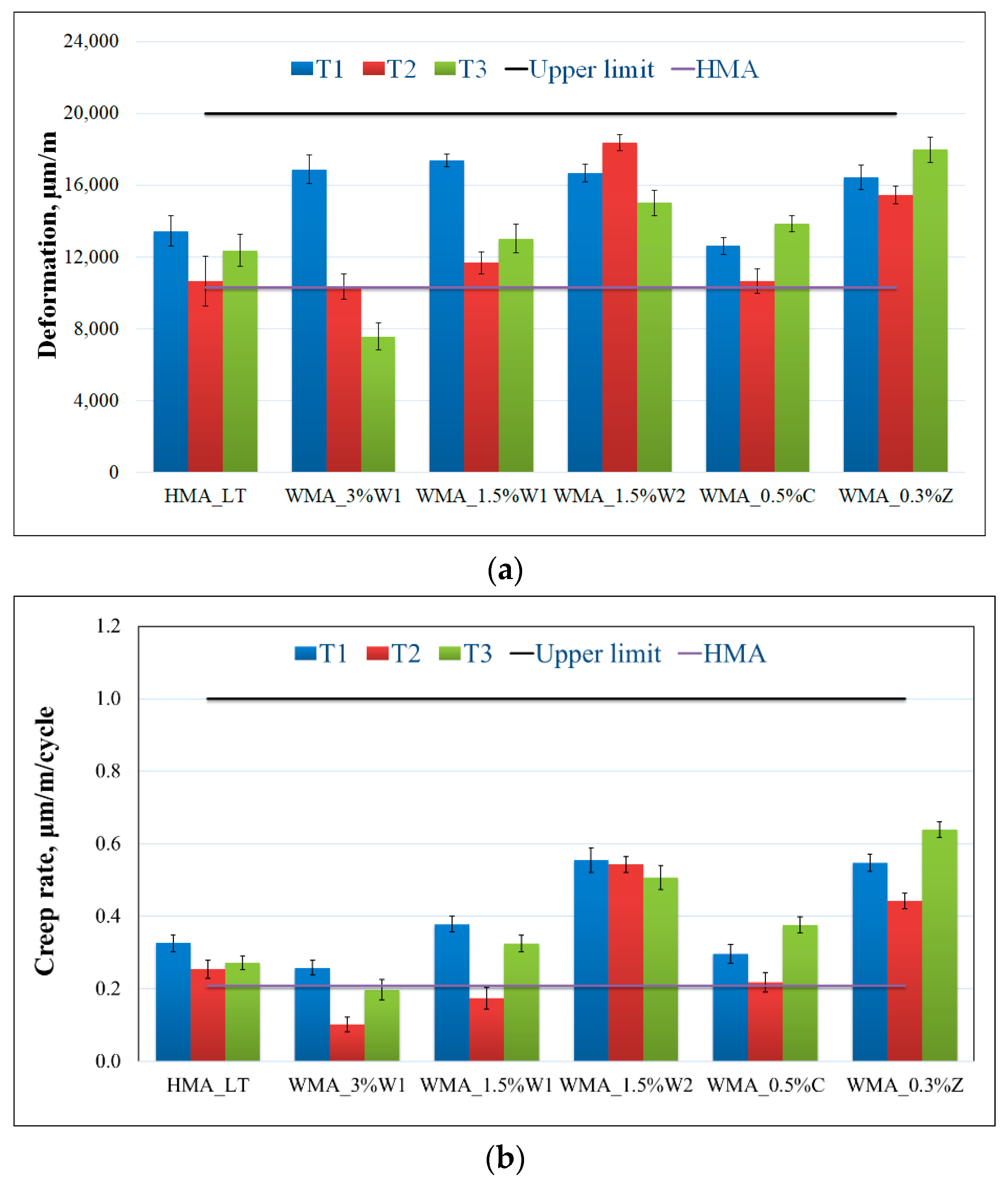
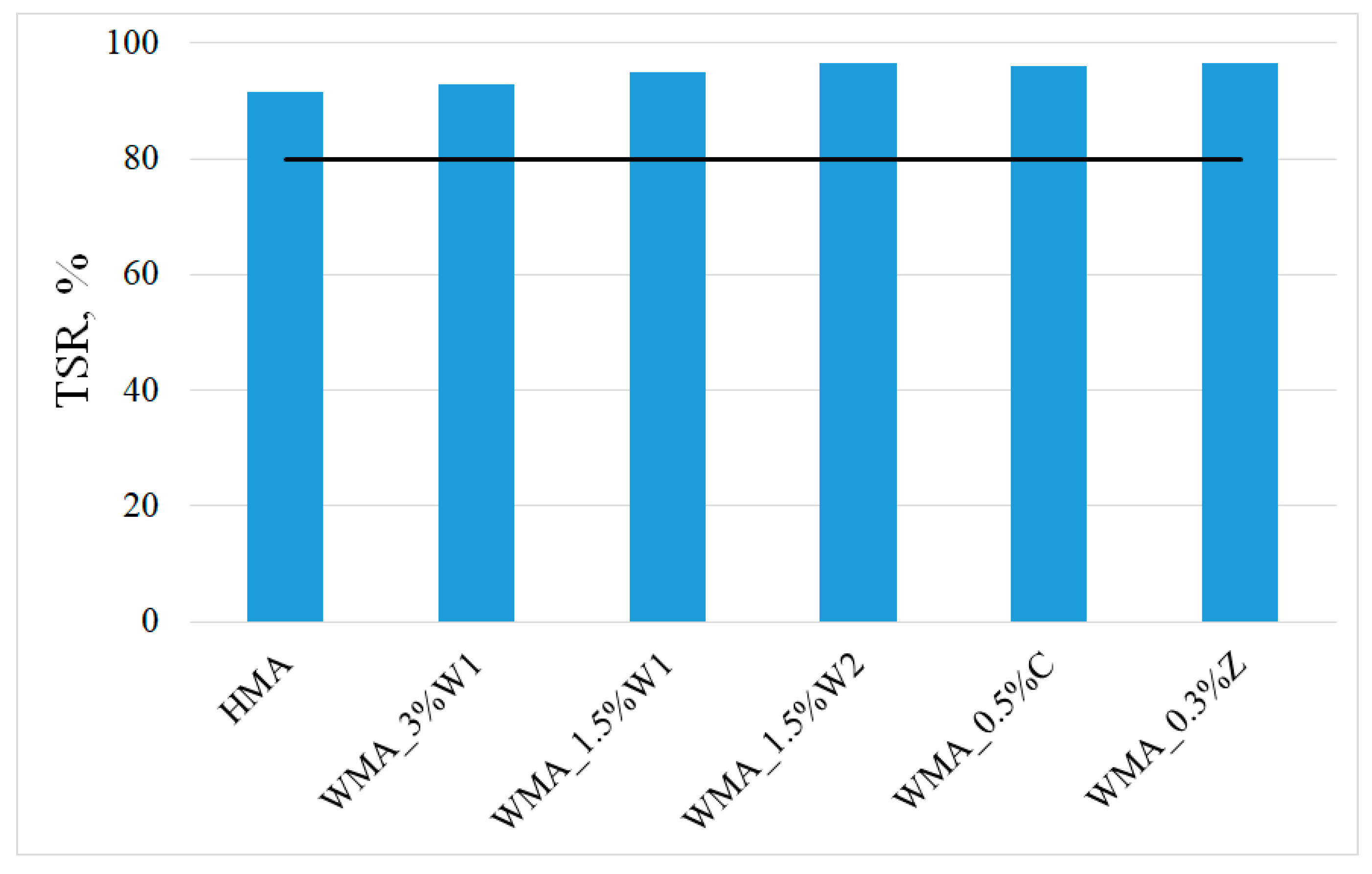
| Test Type | Asphalt Mixture Type | Mixing— Compaction Temperatures (°C) | Test Temperature (°C) | Replicates | Total Number of Tests |
|---|---|---|---|---|---|
| Marshall test | HMA | 160–150 | 60 | 3 | 3 |
| HMA_LT WMA_3%W1 WMA_1.5%W1 WMA_1.5%W2 WMA_0.5%C WMA_0.3%Z | 140–120 120–120 120–100 | 60 | 3 | 54 | |
| Stiffness—indirect tension to cylindrical specimens (IT-CY) | HMA | 160–150 | 20 | 3 | 3 |
| HMA_LT WMA_3%W1 WMA_1.5%W1 WMA_1.5%W2 WMA_0.5%C WMA_0.3%Z | 140–120 120–120 120–100 | 20 | 3 | 54 | |
| Resistance to permanent deformation— triaxial cyclic compression test | HMA | 160–150 | 50 | 3 | 3 |
| HMA_LT WMA_3%W1 WMA_1.5%W1 WMA_1.5%W2 WMA_0.5%C WMA_0.3%Z | 140–120 120–120 120–100 | 50 | 3 | 54 | |
| Water sensitivity—indirect tensile test | HMA | 160–150 | 25 | 3 | 3 |
| HMA_LT WMA_3%W1 WMA_1.5%W1 WMA_1.5%W2 WMA_0.5%C WMA_0.3%Z | 120–120 | 25 | 3 | 18 |
| ID | Mixing Temperature (°C) | Compaction Temperature (°C) |
|---|---|---|
| T1 | 140 | 120 |
| T2 | 120 | 120 |
| T3 | 120 | 100 |
| Compared Distributions | p-Value | ||
|---|---|---|---|
| Marshall Stability | Marshall Flow | Marshall Stability × Marshall Flow/2 | |
| T1–T2 | 0.3838 | 0.5798 | 0.8018 |
| T1–T3 | 0.0000 | 0.0674 | 0.0000 |
| T2–T3 | 0.0000 | 0.1346 | 0.0000 |
| Compared Distributions | p-Value |
|---|---|
| Stiffness Modulus | |
| T1–T2 | 0.5652 |
| T1–T3 | 0.3447 |
| T2–T3 | 0.6739 |
| Compared Distributions | p-Value | |
|---|---|---|
| Deformation | Creep Rate | |
| T1–T2 | 0.1226 | 0.2565 |
| T1–T3 | 0.2002 | 0.9325 |
| T2–T3 | 0.8236 | 0.3318 |
Publisher’s Note: MDPI stays neutral with regard to jurisdictional claims in published maps and institutional affiliations. |
© 2021 by the authors. Licensee MDPI, Basel, Switzerland. This article is an open access article distributed under the terms and conditions of the Creative Commons Attribution (CC BY) license (https://creativecommons.org/licenses/by/4.0/).
Share and Cite
Belc, A.L.; Coleri, E.; Belc, F.; Costescu, C. Influence of Different Warm Mix Additives on Characteristics of Warm Mix Asphalt. Materials 2021, 14, 3534. https://doi.org/10.3390/ma14133534
Belc AL, Coleri E, Belc F, Costescu C. Influence of Different Warm Mix Additives on Characteristics of Warm Mix Asphalt. Materials. 2021; 14(13):3534. https://doi.org/10.3390/ma14133534
Chicago/Turabian StyleBelc, Anda Ligia, Erdem Coleri, Florin Belc, and Ciprian Costescu. 2021. "Influence of Different Warm Mix Additives on Characteristics of Warm Mix Asphalt" Materials 14, no. 13: 3534. https://doi.org/10.3390/ma14133534
APA StyleBelc, A. L., Coleri, E., Belc, F., & Costescu, C. (2021). Influence of Different Warm Mix Additives on Characteristics of Warm Mix Asphalt. Materials, 14(13), 3534. https://doi.org/10.3390/ma14133534






